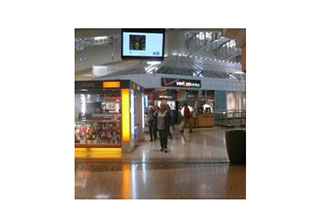Implementing a Digital Signage System at the Mall, Part I
 By Perry Goldstein
By Perry Goldstein
Director of Sales & Marketing, Marshall Electronics
I was shopping for a new couch the other day, so I went to see what was available at the mall. As I was walking through the mall, I went into my “digital signage observer” mode. It’s always been difficult for me to leave the office at the office.
Since I am involved in the industry, I know what state-of-the-art networked systems are available. I wanted to see if that technology has made it down to the average store.
There are malls and stores displaying the latest in digital signage, but based on my casual observances on a day-to-day basis, I was not sure how much it was actually being used.
Not Too Impressed
With smartphone in hand (I tossed out the camera years ago), I started to randomly snap photos of various digital signage deployments. I wanted to see how advanced these systems were, compared to the latest systems I see displayed at trade shows and written about in technology magazines.
I went to a high-end mall in Orange County, Calif. As a point of reference, it is as high-end of a mall as you can get, with all of the most expensive shops and rivaling Rodeo Drive in Beverly Hills, the shopping spot of the Kardashians. I figured if any retailer was using state-of-the-art digital systems, it would be these shops. I was wrong.
There were a few networked systems, but for the most part, the displays were little more than TVs with DVD players — not that there is anything wrong with that. However, with so many new connected systems available, it was interesting to see how slowly the retail world, and even the mall itself, is adopting the latest technology.
The newest digital signage systems can add to the customer experience. They can also improve the intelligence gathering for the retailer, which can help them offer better products and communicate the message better. All of this is supposed to create sales.
So I started to look at these digital signage systems through the eyes of a finance manager. Could the marketing department convince me the investment in this system would pay for itself?
Presenting Digital Signage to Finance
We all know how tight marketing budgets are these days. With so many different ways to spend that money, each marketing dollar has to be closely examined and scrutinized. Should a marketing manager spend $50,000 in store displays or pay-per-click Google keyword searches? Which will bring in the best ROI? And, how exactly is ROI measured? Does every dollar spent need to bring in $5 in sales, or are there other factors involved?
All of this is important to the digital signage industry as we develop products to install into the retail channel. Our job is to design products that will, in one way or another, make the cash register ring. Technology for technology’s sake is not a successful business model. Someone somewhere has to see the value of a digital signage system in order to justify the expense.
With that said, I decided to classify the targeted end results of a digital signage system. There are many reasons one would implement such a system. It may not necessarily be designed to create an immediate sale. In order to purchase and install the right system, its purpose must be determined in advance. Maybe a TV with a DVD player in the window is all that is really needed. Or, maybe upon further discussion, a facial recognition system would be more effective in counting the traffic that views the message.
As part of this series, I will list the criteria I assigned to the judgment process. I based these criteria on my experience of 30-plus years working in and with retailers in building store displays, plus my knowledge of the digital signage technologies currently available:
- Informative
- Entertaining
- Attention getting
- Mood setting
- Selling
- Income generating
- Statement
- Information gathering
This is the first of a two-part series. The final part, next week, will address and explain each of these criteria as well as examples of each system.
 Perry Goldstein, CTS is a veteran of the electronics industry, with both consumer and industrial electronics experience. His experience includes all aspects of the industry, from product inception and design to marketing and sales. He is also a professional speaker and writer for the digital signage industry. Goldstein is currently the director of sales & marketing for Marshall Electronics and MXL pro audio division. He is also a musician and song leader for Friendship Circle, an organization for special needs children and which he enjoys as a hobby. For further information related to this article, contact Perry Goldstein at perry.goldstein@gmail.com.
Perry Goldstein, CTS is a veteran of the electronics industry, with both consumer and industrial electronics experience. His experience includes all aspects of the industry, from product inception and design to marketing and sales. He is also a professional speaker and writer for the digital signage industry. Goldstein is currently the director of sales & marketing for Marshall Electronics and MXL pro audio division. He is also a musician and song leader for Friendship Circle, an organization for special needs children and which he enjoys as a hobby. For further information related to this article, contact Perry Goldstein at perry.goldstein@gmail.com.
This article was reprinted with permission from the Digital Signage Connection and originally appeared here.





